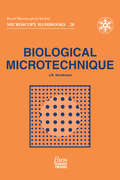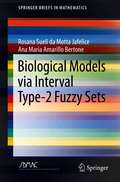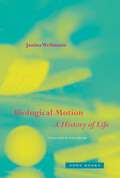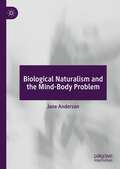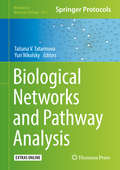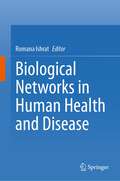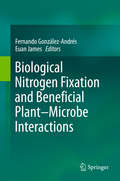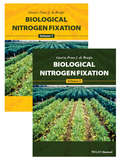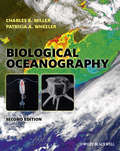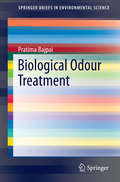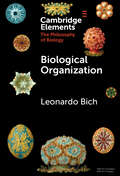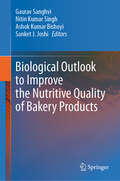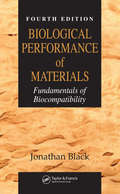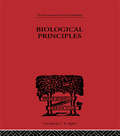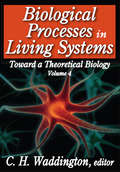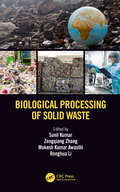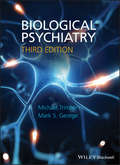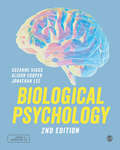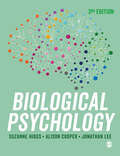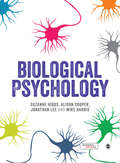- Table View
- List View
Biological Microtechnique
by Jeremy SandersonA completely new practical guide to both new and classical methods of slide-making which is easy-to-read and easy-to-understand. Biological Microtechnique contains a wealth of practical detail which will provide a firm grounding in preparative methods for light microscopy.
Biological Models via Interval Type-2 Fuzzy Sets (SpringerBriefs in Mathematics)
by Rosana Sueli Jafelice Ana Maria Amarillo BertoneThis book offers a gentle introduction to type-2 fuzzy sets and, in particular, interval type-2 fuzzy sets and their application in biological modeling. Interval type-2 fuzzy modeling is a comparatively recent direction of research in fuzzy modeling. As the modeling of biological problems is inherently uncertain, the use of fuzzy sets in this field is a natural choice.The coverage begins with a succinct review of type-1 fuzzy basic theory, before providing a comprehensive and didactic explanation of type-2 fuzzy set components. In turn, Fuzzy Rule-Based Systems, or FRBS, are shown for both types, interval type-2 and type-1 fuzzy sets.Applications include the pharmacological models, prediction of prostate cancer stages, a model for HIV population transfer (asymptomatic to symptomatic), an epidemiological disease caused by HIV, some models in population growth, included the Malthus Model, and an epidemic model refers to COVID-19. The book is ideally suited to graduate students in mathematics and related fields, professionals, researchers, or the public interested in interval type-2 fuzzy modeling. Largely self-contained, it can also be used as a supplementary text in specialized graduate courses.
Biological Motion: A History of Life
by Janina WellmannA captivating exploration of the changing definitions of life in biologyBiological Motion studies the foundational relationship between motion and life. To answer the question, &“What is Life?,&” prize-winning historian of science Janina Wellmann engages in a transdisciplinary investigation of motion as the most profound definition of living existence.For decades, information and structure have dominated the historiography of the life sciences with its prevailing focus on DNA structure and function. Now more than ever, motion is a crucial theme of basic biological research. Tracing motion from Aristotle&’s animal soul to molecular motors, and from medical soft robotics to mathematical analysis, Wellmann locates biological motion at the intersection of knowledge domains and scientific and cultural practices. She offers signposts to mark the sites where researchers, technologies, ideas, and practices opened up new paths in the constitution of the phenomenon of motion. An ambitious rethinking of the life sciences, Biological Motion uncovers the secret life of movement and offers a new account of what it means to be alive.
Biological Naturalism and the Mind-Body Problem
by Jane AndersonThis book offers a new theoretical framework within which to understand “the mind-body problem”. The crux of this problem is phenomenal experience, which Thomas Nagel famously described as “what it is like” to be a certain living creature. David Chalmers refers to the problem of “what-it-is-like” as “the hard problem” of consciousness and claims that this problem is so “hard” that investigators have either just ignored the issue completely, investigated a similar (but distinct) problem, or claimed that there is literally nothing to investigate – that phenomenal experience is illusory. This book contends that phenomenal experience is both very real and very important. Two specific “biological naturalist” views are considered in depth. One of these two views, in particular, seems to be free from problems; adopting something along the lines of this view might finally allow us to make sense of the mind-body problem.An essential read for anyone who believes that no satisfactory solution to “the mind-body problem” has yet been discovered.
Biological Networks and Pathway Analysis (Methods in Molecular Biology #1613)
by Yuri Nikolsky Tatiana V. TatarinovaIn this volume, expert practitioners present a compilation of methods of functional data analysis (often referred to as "systems biology") and its applications in drug discovery, medicine, and basic disease research. It covers such important issues as the elucidation of protein, compound and gene interactions, as well as analytical tools, including networks, interactome and ontologies, and clinical applications of functional analysis. As a volume in the highly successful Methods in Molecular Biology series, this work provides detailed description and hands-on implementation advice. Reputable, comprehensive, and cutting-edge, Biological Networks and Pathway Analysis presents both "wet lab" experimental methods and computational tools in order to cover a broad spectrum of issues in this fascinating new field.
Biological Networks in Human Health and Disease
by Romana IshratThis book presents methods and tools of network biology and bioinformatics for understanding the disease dynamics and identification of drug targets. The initial section of chapters introduce the theoretical aspects followed by the different applications for construction and analysis of biological networks, methods for identifying crucial nodes in networks, and network dynamics. The book covers the latest advances in the network medicine, exploring the different types of biological networks, and their applications. It further reviews the role of R language in the network-based approaches that help in understanding biological systems and identifying biological functions. Towards the end, the book explores the recent developments and applications in machine learning and its potential for advancing network biology. Finally, the book elucidates a comprehensive yet a representative description of challenges associated with the understanding of disease dynamics using network biology. Given its scope, the book is intended for researchers and advanced postgraduate students of bioinformatics, computational biology, and medical sciences.
Biological Nitrogen Fixation and Beneficial Plant-Microbe Interaction
by Fernando González-Andrés Euan JamesThis book covers the most recent advances in all the topics with which researchers and professionals need to be familiar in order to obtain a better understanding of, and to better exploit, beneficial plant-microbe interactions. The use of microorganisms for agriculture and environmental applications is gaining importance worldwide to improve crop performance, but also for other environmental applications, such as bioremediation in chemically polluted soils. The search for an equilibrium between fundamental and applied aspects makes this book useful for professionals at various levels in the value chain of the "microbial biofertilizers". Challenges of comercializing biofertilizers involve efficiency of the products and safety for human health and the environment, topics that have paid central attention in this book. Students, scientists and biofertilizers developers will find updated and comprehensive information about the different aspects to be considered to address a successful introduction of biofertilizers in sustainable agriculture and environmental actions.
Biological Nitrogen Fixation, 2 Volume Set
by Frans J. de BruijnNitrogen is arguably the most important nutrient required by plants. However, the availability of nitrogen is limited in many soils and although the earth's atmosphere consists of 78.1% nitrogen gas (N2) plants are unable to use this form of nitrogen. To compensate , modern agriculture has been highly reliant on industrial nitrogen fertilizers to achieve maximum crop productivity. However, a great deal of fossil fuel is required for the production and delivery of nitrogen fertilizer. Moreover carbon dioxide (CO2) which is released during fossil fuel combustion contributes to the greenhouse effect and run off of nitrate leads to eutrophication of the waterways. Biological nitrogen fixation is an alternative to nitrogen fertilizer. It is carried out by prokaryotes using an enzyme complex called nitrogenase and results in atmospheric N2 being reduced into a form of nitrogen diazotrophic organisms and plants are able to use (ammonia). It is this process and its major players which will be discussed in this book. Biological Nitrogen Fixation is a comprehensive two volume work bringing together both review and original research articles on key topics in nitrogen fixation. Chapters across both volumes emphasize molecular techniques and advanced biochemical analysis approaches applicable to various aspects of biological nitrogen fixation. Volume 1 explores the chemistry and biochemistry of nitrogenases, nif gene regulation, the taxonomy, evolution, and genomics of nitrogen fixing organisms, as well as their physiology and metabolism. Volume 2 covers the symbiotic interaction of nitrogen fixing organisms with their host plants, including nodulation and symbiotic nitrogen fixation, plant and microbial "omics", cyanobacteria, diazotrophs and non-legumes, field studies and inoculum preparation, as well as nitrogen fixation and cereals. Covering the full breadth of current nitrogen fixation research and expanding it towards future advances in the field, Biological Nitrogen Fixation will be a one-stop reference for microbial ecologists and environmental microbiologists as well as plant and agricultural researchers working on crop sustainability.
Biological Oceanography
by Patricia A. Wheeler Charles B. MillerThis new edition of Biological Oceanography has been greatly updated and expanded since its initial publication in 2004. It presents current understanding of ocean ecology emphasizing the character of marine organisms from viruses to fish and worms, together with their significance to their habitats and to each other. The book initially emphasizes pelagic organisms and processes, but benthos, hydrothermal vents, climate-change effects, and fisheries all receive attention. The chapter on oceanic biomes has been greatly expanded and a new chapter reviewing approaches to pelagic food webs has been added. Throughout, the book has been revised to account for recent advances in this rapidly changing field. The increased importance of molecular genetic data across the field is evident in most of the chapters. As with the previous edition, the book is primarily written for senior undergraduate and graduate students of ocean ecology and professional marine ecologists. Visit www.wiley.com/go/miller/oceanography to access the artwork from the book.
Biological Oceanography
by Eric MillsFirst published in 1989, Eric L. Mills's comprehensive history of biological oceanography has been praised as 'superb' (BioScience) and 'proof that history need not be dull' (The Northern Mariner). This first history of the field, which chronicles the scientific work and creativity of its chief contributors, tells a riveting story that is far from narrowly scientific and thoroughly accessible to general readers. Mills shows how the work and ideas of the main actors are inseparable from some seemingly unrelated factors, including Prussian imperialism, agricultural chemistry, microbiology, and the problems of German universities. Mills also illustrates the significant roles played in the field's development by the failures of commercial fisheries, the development of analytical chemistry, the establishment of international scientific organizations, and sheer scientific curiosity.This new edition of Biological Oceanography includes a fresh introduction by the author, as well as an original foreword by noted oceanographer John Cullen. It makes an excellent companion to Mills's recent history of mathematical and physical oceanography, the multi-award-winning and widely acclaimed The Fluid Envelope of Our Planet.
Biological Oceanography of the Baltic Sea
by Teresa Radziejewska Hendrik Schubert Pauline Snoeijs-LeijonmalmThis is the first comprehensive science-based textbook on the biology and ecology of the Baltic Sea, one of the world's largest brackish water bodies. The aim of this book is to provide students and other readers with knowledge about the conditions for life in brackish water, the functioning of the Baltic Sea ecosystem and its environmental problems and management. It highlights biological variation along the unique environmental gradients of the brackish Baltic Sea Area (the Baltic Sea, Belt Sea and Kattegat), especially those in salinity and climate. pt;font-family:"Arial","sans-serif"; color:#262626">The first part of the book presents the challenges for life processes and ecosystem dynamics that result from the Baltic Sea's highly variable recent geological history and geographical isolation. The second part explains interactions between organisms and their environment, including biogeochemical cycles, patterns of biodiversity, genetic diversity and evolution, biological invasions and physiological adaptations. In the third part, the subsystems of the Baltic Sea ecosystem - the pelagic zone, the sea ice, the deep soft sea beds, the phytobenthic zone, the sandy coasts, and estuaries and coastal lagoons - are treated in detail with respect to the structure and function of communities and habitats and consequences of natural and anthropogenic constraints, such as climate change, discharges of nutrients and hazardous substances. Finally, the fourth part of the book discusses monitoring and ecosystem-based management to deal with contemporary and emerging threats to the ecosystem's health.
Biological Odour Treatment (SpringerBriefs in Environmental Science)
by Pratima BajpaiShowcasing the very latest technologies for neutralising the unpleasant--and sometimes dangerous--odours from industrial and waste management processes, this Springer Brief in Environmental Sciences covers physical, chemical and biological methods. The volume includes modern biotechnological approaches now making it cost-effective to tackle malodorous chemicals at very small concentrations. The book reflects the fact that odour affects us in several ways, which range from compromising our quality of life to causing respiratory and other unpleasant conditions and from depressing property values to severe health problems caused by the toxic stimulants of odours. Innumerable industrial processes release malodourous and harmful vapours. The human sense of smell can detect some noxious chemicals, such as the sulphurous by-products of paper manufacturing, at concentrations of one part per billion. This e-book shows what has been achieved in combating offensive and harmful odours. While conventional air pollution control technologies can treat a wide variety of pollutants at higher concentrations, the chapters cover the more refined biological methods used to deal with odours and volatile organic compounds in low concentrations. These include bio scrubbers and bio trickling filters. Standing alongside its detailed discussion of the health impacts of total reduced sulphur compounds, and the composition of paper pulp industry emissions, this publication offers comprehensive and in-depth treatment of some of the most potent anti-odour technologies yet devised.
Biological Organization (Elements in the Philosophy of Biology)
by Leonardo BichLiving systems are complex systems made of components that tend to degrade, but nonetheless they maintain themselves far from equilibrium. This requires living systems to extract energy and materials from the environment and use them to build and repair their parts by regulating their activities based on their internal and external conditions in ways that allow them to keep living. The philosophical and theoretical approach discussed in this Element aims to explain these features of biological systems by appealing to their organization. It addresses classical and more recent issues in philosophy of biology, fromorigins and definitions of life to biological teleology and functions, from an original perspective mainly focused on the living system, its physiology and behavior, rather than evolution. It discusses and revises the conceptual foundations of this approach and presents an updated version of it. This title is also available as Open Access on Cambridge Core.
Biological Outlook to Improve the Nutritive Quality of Bakery Products
by Nitin Kumar Singh Sanket J. Joshi Gaurav Sanghvi Ashok Kumar BishoyiThis book aims to bring the focus on biological viewpoint and alternatives for producing the baked goods, as the confectionary is a major market segment comprising of the sugar and baked products. The bakery products include major segments including cereals, bread, chocolates, cookies, and other confectionary items. This book provides the data regarding the market of baked goods, as it is forecasted to increase at growth rate of 5.8% (CAGR) and it’s expected to reach around its growth around (7%) by 2025 (Fortune insights 2022). The book also classifies amongst the major consumers worldwide, Asia pacific contributes around 43%, western Europe contributes around 22% while Africa continent represents as smallest group of consumers for baked confectionary consumers. The book provides information regarding health concerns as baked goods are liked by population of all ages. As per the data mentioned above the bakery goods are consumed heavily without clear insights about its health concerns. Majority of baked goods are made up of all-purpose flour having serious risk concerns/impact on health and higher consumption of bakery goods can increase sugar, cholesterol level and can also cause further problem in liver or heart functions. Although, gluten free, multigrain baked confectionaries are now a day’s available in the market but the still the better understanding of the bio-based products is need of current time. The biological viewpoint especially for the bakery goods can serve as initial point for better handling baked goods in context of upbringing of healthy society. The book targets students and researchers interested in interdisciplinary research and devising novel biological applications with special focus on bakery products.
Biological Performance of Materials: Fundamentals of Biocompatibility, Fourth Edition
by Jonathan BlackBioengineers need a thorough grounding in biocompatibility - the biological performance of materials. Until now, there were no publications suitable for a neophyte in the field; prior publications were either not comprehensive or focused on rather narrow interests. Drawing on the author's 35 years of experience as a teacher, researcher, and consult
Biological Principles: A Critical Study (International Library of Philosophy #Vol. 6)
by J.H. WoodgerFirst published in 2000. Routledge is an imprint of Taylor & Francis, an informa company.
Biological Processes in Living Systems: Toward A Theoretical Biology (Toward a Theoretical Biology)
by C. H. WaddingtonBiological Processes in Living Systems is the fourth and final volume of the Toward a Theoretical Biology series. It contains essays that deal in detail with particular biological processes: morphogenesis of pattern, the development of neuronal networks, evolutionary processes, and others. The main thrust of this volume brings relevance to the general underlying nature of living systems. Faced with trying to understand how the complexity of molecular microstates leads to the relative simplicity of phenome structures, Waddington-on behalf of his colleagues-stresses on the structure of language as a paradigm for a theory of general biology. This is language in an imperative mood: a set of symbols, organized by some form of generative grammar, making possible the conveyance of commands for action to produce effects on the surroundings of the emitting and the receiving entities. "Biology," he writes, "is concerned with algorithm and program." Among the contributions in this volume are: "The Riemann-Hugoniot Catastrophe and van der Waals Equation," David H. Fowler; "Differential Equations for the Heartbeat and Nerve Impulse," E. Christopher Zeeman; "Structuralism and Biology," Rene Thom; "The Concept of Positional Information and Pattern Formation," Lewis Wolpert; "Pattern Formation in Fibroblast Cultures," Tom Elsdale; "Form and Information," C. H. Waddington; "Organizational Principles for Theoretical Neurophysiology," Michael A. Arbib; "Stochastic Models of Neuroelectric Activity," Jack D. Cowan. Biological Processes in Living Systems is a pioneering volume by recognized leaders in an ever-growing field.
Biological Processing of Solid Waste
by Sunil Kumar, Zengqiang Zhang, Mukesh Kumar Awasthi, and Ronghua LiOffering a comprehensive approach, this title covers fundamentals, technologies, and management of biological processing of solid waste. It discusses kinetic modeling and synergistic impact evolution during bioprocessing of solid waste, environmental impacts such as greenhouse gas emission from biological processing of solid waste, energy recovery from solid waste, and biodrying of solid waste. It also presents cases and challenges from different countries, successful business models, and economic analyses of various processing options. Aimed at researchers and industry professionals in solid and hazardous waste management, this title offers a wealth of knowledge to help readers understand this increasingly important area.
Biological Psychiatry
by Michael R. Trimble Mark GeorgeBiological psychiatry has dominated psychiatric thinking for the past 40 years, but the knowledge base of the discipline has increased substantially more recently, particularly with advances in genetics and neuroimaging. The third edition of Biological Psychiatry has been thoroughly updated taking into account these developments. As in the earlier editions of the book, there are comprehensive reviews and explanations of the latest advances in neurochemistry, neuroanatomy, genetics and brain imaging-- descriptions not only of methodologies but also of the application of these in clinical settings. It is within this context that there is a considerable emphasis in the book on brain-behaviour relationships both within and without the clinical setting.This edition has been enhanced by the inclusion of new chapters, one on anxiety and another on motivation and the addictions. The chapter that relates to treatments has been extended to include the latest information on brain stimulation techniques. The overall book is well illustrated in order to help with an understanding of the text.For the third edition, Professor Michael Trimble has been joined by Professor Mark George as co-author. These are two of the world's leading biological psychiatrists who both have considerable clinical as well as research experience which they have brought to the book. Unlike multiauthored texts, it has a continuity running through it which aids understanding and prevents repetition.This book is strongly recommended for all practising psychiatrists and trainees wishing for an up-to-date, authoritative, easy to digest and acessible review of the latest advances and conceptualizations in the field. It will also appeal to neurologists interested in neuropsychiatry and biological psychiatry or the psychiatric aspects of neurological disorders, as well as other practising clinicians (psychologists, social workers, nurses) in the mental health field.
Biological Psychology
by Alison Cooper Dr Suzanne Higgs Dr. Jonathan LeeThe challenge of teaching bio-psychology is first getting students up to speed with the basic brain functions and terminology, before this can be applied to psychology, and then finally helping them develop critical thinking about the subject. This book uniquely addresses all three of these issues and provides a resource that supports students at each of these different levels of understanding. Key features include: • New video animations for the biology chapters and high-quality illustrations throughout, helping students grasp the basic neuroanatomy and microbiology. • 'Check your understanding' questions in the book and MCQs online help students test their understanding and prepare for assessments. • Chapters cover the need-to-know topics for psychology students with 'Insight' and 'Focus on Methods' boxes, highlighting these topics' relevance to the real-world. • Spotlights build on the chapters, delving deeper into contemporary debates, issues and controversies around topical areas such as post-traumatic stress disorder, obesity and pain.
Biological Psychology
by Alison Cooper Dr Suzanne Higgs Dr. Jonathan LeeThe challenge of teaching bio-psychology is first getting students up to speed with the basic brain functions and terminology, before this can be applied to psychology, and then finally helping them develop critical thinking about the subject. This book uniquely addresses all three of these issues and provides a resource that supports students at each of these different levels of understanding. Key features include: • New video animations for the biology chapters and high-quality illustrations throughout, helping students grasp the basic neuroanatomy and microbiology. • 'Check your understanding' questions in the book and MCQs online help students test their understanding and prepare for assessments. • Chapters cover the need-to-know topics for psychology students with 'Insight' and 'Focus on Methods' boxes, highlighting these topics' relevance to the real-world. • Spotlights build on the chapters, delving deeper into contemporary debates, issues and controversies around topical areas such as post-traumatic stress disorder, obesity and pain.
Biological Psychology
by Jonathan Lee Suzanne Higgs Alison CooperBiological Psychology offers a highly visual, in-depth guide to the basic biological functions of the brain that you will need to learn throughout the course of your psychology degree. This edition boasts a revamped learning structure with a strong applied focus. This allows you to engage with biological psychology through a range of real world applications, getting you to apply your learning to conditions such as epilepsy, PTSD and Parkinson’s, and treatments such as gene therapy and brain-computer interfaces for spinal cord injuries. Key features include: • New ′real world applications′ boxes that help put theory into practice, showing you the human side of the science • ′Focus on methods′ boxes that demonstrate the research methods you will use as a biological psychologist to uncover the workings of the brain • Key debates to deepen your understanding of contemporary research and its impact • Critical thinking questions • Key points and glossary definitions to solidify your understanding of complex ideas and new terminology • Further reading suggestions to help build your bibliography for assignments • Video animations to help you grasp basic neuroanatomy and psychobiology This book goes above and beyond to familiarise you with the links between biology and psychology, making it an essential read for psychology students at all levels. Suzanne Higgs is Professor in the Psychobiology of Appetite at the University of Birmingham. Alison Cooper is a Senior Lecturer at the University of Birmingham. Jonathan Lee is Professor of Memory Neuroscience at the University of Birmingham.
Biological Psychology
by Jonathan Lee Suzanne Higgs Alison CooperBiological Psychology offers a highly visual, in-depth guide to the basic biological functions of the brain that you will need to learn throughout the course of your psychology degree. This edition boasts a revamped learning structure with a strong applied focus. This allows you to engage with biological psychology through a range of real world applications, getting you to apply your learning to conditions such as epilepsy, PTSD and Parkinson’s, and treatments such as gene therapy and brain-computer interfaces for spinal cord injuries. Key features include: • New ′real world applications′ boxes that help put theory into practice, showing you the human side of the science • ′Focus on methods′ boxes that demonstrate the research methods you will use as a biological psychologist to uncover the workings of the brain • Key debates to deepen your understanding of contemporary research and its impact • Critical thinking questions • Key points and glossary definitions to solidify your understanding of complex ideas and new terminology • Further reading suggestions to help build your bibliography for assignments • Video animations to help you grasp basic neuroanatomy and psychobiology This book goes above and beyond to familiarise you with the links between biology and psychology, making it an essential read for psychology students at all levels. Suzanne Higgs is Professor in the Psychobiology of Appetite at the University of Birmingham. Alison Cooper is a Senior Lecturer at the University of Birmingham. Jonathan Lee is Professor of Memory Neuroscience at the University of Birmingham.
Biological Psychology
by Mike Harris Dr Suzanne Higgs Dr Jonathan H. Lee Dr Alison CooperWritten to guide undergraduate students new to brain and behaviour through the key biological concepts that determine how we act, Biological Psychology provides a comprehensive introduction to the subject. It includes detailed coverage of sensation, movement, sleep, eating and emotions, with further chapters on the biological basis of psychological disorders and the effects of drug-taking. Uniquely, the authors emphasize the importance of learning and memory as a key thread throughout and include advanced chapters on key research areas that push discussion further and encourage critical thinking, making this book appropriate for undergraduates studying biological psychology at any level. Key features include: ‘Spotlights’ offering insights into key areas of research that expose the most important developing issues in the field today A clear structure including roadmaps and key points for each chapter to ease navigation through the book and understanding of the links between concepts Full colour presentation to bring the topics to life through clear and comprehensive illustrations and diagrams A companion website at study.sagepub.com/higgs with a range of materials for instructors and students
Biological Psychology
by Mike Harris Dr Suzanne Higgs Dr Jonathan H. Lee Dr Alison CooperWritten to guide undergraduate students new to brain and behaviour through the key biological concepts that determine how we act, Biological Psychology provides a comprehensive introduction to the subject. It includes detailed coverage of sensation, movement, sleep, eating and emotions, with further chapters on the biological basis of psychological disorders and the effects of drug-taking. Uniquely, the authors emphasize the importance of learning and memory as a key thread throughout and include advanced chapters on key research areas that push discussion further and encourage critical thinking, making this book appropriate for undergraduates studying biological psychology at any level. Key features include: 'Spotlights' offering insights into key areas of research that expose the most important developing issues in the field today A clear structure including roadmaps and key points for each chapter to ease navigation through the book and understanding of the links between concepts Full colour presentation to bring the topics to life through clear and comprehensive illustrations and diagrams A companion website at study.sagepub.com/higgs with a range of materials for instructors and students
